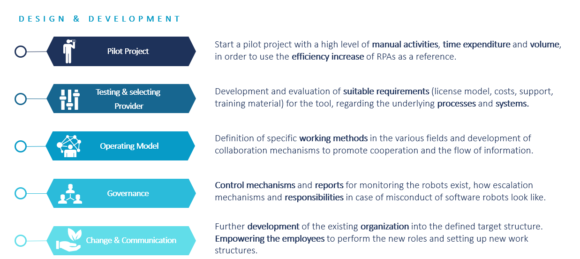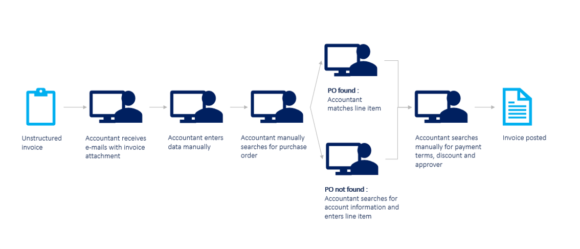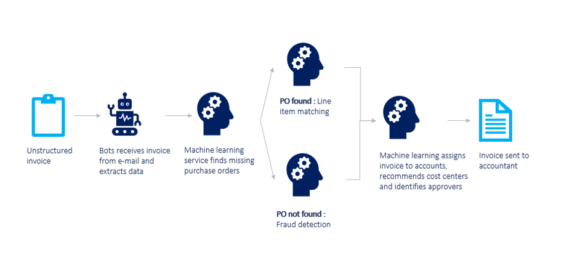Digitization affects every company and raises a variety of challenges and innovations, requiring changes of business models, corporate culture and organization as well as business processes. One of these innovations is the “Robotic Process Automation”, or RPA for short, which can benefit organizations in many areas such as controlling.
What is an effective RPA implementation methodology?
Especially in a commercial environment, RPA makes everyday life easier, as it has the potential to take over highly schematic tasks and processes. RPA subsumes a multitude of automation possibilities based on various tools and functionalities. This results in advantages like saving costs, time, or reduction of errors.
The procedure is based on a multi-stage process from the analysis of the current situation, where the status quo is determined, to the presentation of various scenarios. Of essential importance is the configuration of a robot. For the configuration of automated processes, a comprehensive understanding of the process, knowledge of the system used, the respective area of application and the legal requirements must be available. Furthermore, the step to be automated must be matched with a suitable selection of proven tools. Tools that can be used include intelligent text recognition, data analysis software or dashboards for visual presentation of the results. Based on this, as in Figure 1, the following points should be considered for a successful introduction:

For which areas can RPA be applied?
Considering the situation described above and the implementation process, these activities show possible use scenarios for the RPA:
- Merging data / information from different sources
- Creation of standardized reports
- Validation & Control (e.g. customer data maintenance)
- Detection of differences
- Archiving of reports & dispatch
- Interactions with the user (e.g. processing of orders)
Based on our project experience, the areas of management reporting, profit & loss and operational planning have been identified where RPA works particularly efficiently. In the area of management reporting, RPA can support the achievement of the goal of providing decision-makers at all levels of the company with updated information. This support could be used for recurring standard reports. RPA supported reporting reduces the workload of the controlling department often simple, but very costly activities. Accordingly, the saved resources can be used for the further development of the business. However, it is important to look at an exact use case and analyses, how RPA affects a process.
How does RPA benefits businesses in the Account Payable Processing?
The Account Payable Processing Automation is one of the many possibilities which can be achieved by RPA. For a large distributor, the collection, validation, and processing of supplier invoices is time-consuming and error-prone without having automated tasks in place. This is mainly due to the highly manual accounts payable (AP) processes, partially automated processes using complex scripts, lack of integration between process steps and manual matching processes for invoices, purchase orders, and financial posting. As it is displayed in Figure 2, in a Manual Account Payable Process, after the accountants receive the unstructured invoices via emails, they manually enter the data and search for purchase orders. If the purchase order is found, the accountants match the line item and if not, they search for the account information and insets the line item by themselves. Afterwards, accountants search for information regarding payment term, discount and approver and post the invoice.

Intelligent RPA application combined with machine learning provides the capabilities to extract and handle unstructured data from e-mails or PDFs, automate matching, locate purchase orders, detect fraud, and automatically upload and post spreadsheet data. Figure 3 indicates that in an Automated Account Payable Process the bots receive and extract the data from unstructured invoices. Then, the machine learning service finds the purchase orders and matches the line items. In case that no purchase order can be found the system reports fraud. Afterwards, the system automatically assigns the invoice to the accounts, recommends cost centers, identifies approvers, and sends the final invoice to the accountant.

It has been suggested that the implementation of an automated account payable process can benefit the distributer in several ways in terms of efficiency and effectiveness as follows:
- 80% reduction in data entry time with automated
data upload - Higher data accuracy while extracting and entering data in AP systems
- Improved employee experience for financial controllers
- Increased efficiency of finance operations with
auditable trails - Additional time for experts to focus on exceptions
With the CAMELOT concept for RPA approach we can support our customers in the implementation of the RPA method and show useful cases. Our CAMELOT experts are available for possible scenarios and looking forward to hearing from you.
